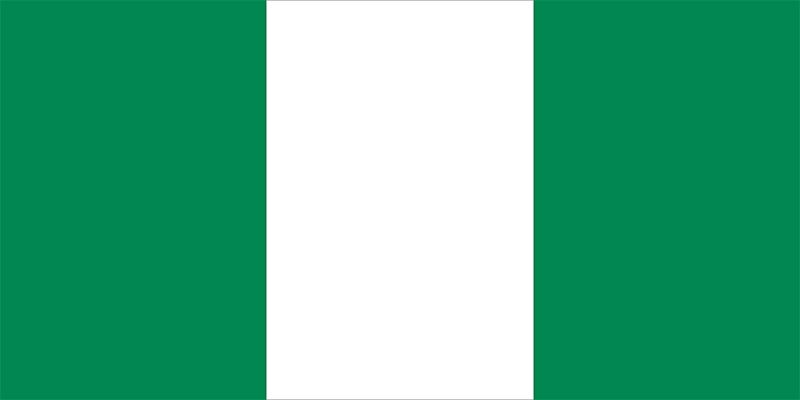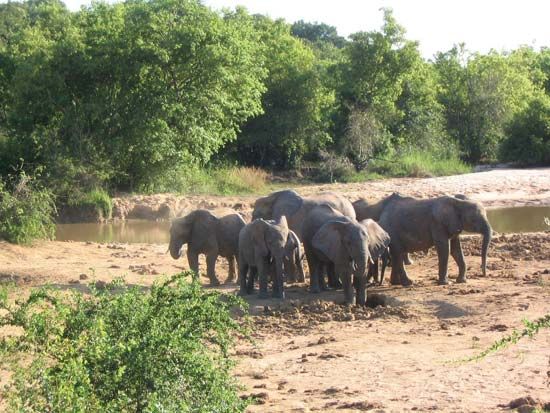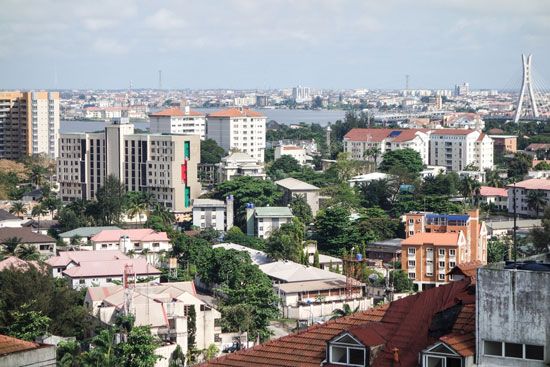
 national anthem of Nigeria
national anthem of Nigeria


 Nigeria lies in West Africa. It has a varied geography that includes rainforests and grasslands.
Nigeria lies in West Africa. It has a varied geography that includes rainforests and grasslands.
- Neighboring countries: Benin, Niger, Chad, Cameroon
- Bodies of water: the Gulf of Guinea, which is part of the Atlantic Ocean, lies to the south; Lake Chad is in the northeastern corner
- Regions:
- Mountains: Gotel Mountains at the southeast border; Shebshi Mountains in the east
- Highest point: Chappal Waddi—7,936 feet (2,419 meters)
- Major rivers: Niger, Benue
- Major cities: Abuja, Lagos, Kano, Benin City, Ibadan, Kaduna
Nigeria has a warm climate with rainy and dry seasons. The southeast receives the most rain. The north is the driest region, and droughts are common there. The harmattan is a dry and dusty northeast wind that blows for more than three months in the north.
Swamps and mangrove trees line the coast in the south of Nigeria. The swamps give way to tropical rainforests. In various areas of the south, much of the forests have been cleared for oil palm and for cacao and rubber plantations. North of the forest belt is savanna, where baobab, tamarind, and locust bean trees grow. Grasses and scattered trees grow in the dry north.
 Many of Nigeria’s larger animals can be found only in the country’s multiple national parks that cover the savanna and the rainforest regions. Animals in the parks include lions, baboons, giraffes, hyenas, antelope, forest elephants, chimpanzees, leopards, gorillas, and monkeys. Nigeria’s other wild animals include snakes, crocodiles, and hippopotamuses. There are hundreds of different kinds of birds in Nigeria, including ostriches, storks, and parrots.
Many of Nigeria’s larger animals can be found only in the country’s multiple national parks that cover the savanna and the rainforest regions. Animals in the parks include lions, baboons, giraffes, hyenas, antelope, forest elephants, chimpanzees, leopards, gorillas, and monkeys. Nigeria’s other wild animals include snakes, crocodiles, and hippopotamuses. There are hundreds of different kinds of birds in Nigeria, including ostriches, storks, and parrots.


 There are about 250 ethnic groups in Nigeria. Each has its own customs and language. The three major ethnic groups are the Hausa-Fulani, the Yoruba, and the Igbo. More people speak Hausa than any other language. English is the language of the government.
There are about 250 ethnic groups in Nigeria. Each has its own customs and language. The three major ethnic groups are the Hausa-Fulani, the Yoruba, and the Igbo. More people speak Hausa than any other language. English is the language of the government.
About half of the population is Muslim, and nearly half is Christian. A little more than half the population lives in urban areas.
 Nigerian culture is the culture of the hundreds of different ethnic groups within its borders. However, throughout the country the family is the central institution in Nigeria. Families gather for all big life events, from births to weddings to funerals.
Nigerian culture is the culture of the hundreds of different ethnic groups within its borders. However, throughout the country the family is the central institution in Nigeria. Families gather for all big life events, from births to weddings to funerals.
Food in Nigeria varies greatly based on the cultures and regions. Beans, root vegetables, and rice are eaten throughout the country. Other grains, such as millet and wheat, are a large part of the diet in the north. In the south, a variety of soups containing tomatoes, onions, red pepper, palm oil, okra, meat, or fish are prepared.

 The rich tradition of literature in Nigeria began with storytelling. Stories were passed down for thousands of years. Eventually, many of them were written down. Popular Nigerian writers include Wole Soyinka, Chinua Achebe, Flora Nwapa, and Chimamanda Ngozi Adichie.
The rich tradition of literature in Nigeria began with storytelling. Stories were passed down for thousands of years. Eventually, many of them were written down. Popular Nigerian writers include Wole Soyinka, Chinua Achebe, Flora Nwapa, and Chimamanda Ngozi Adichie.
 Music and dance are an important part of Nigerian culture. Each ethnic group has its own specialties. Music is often used in important rituals and ceremonies. Traditional instruments include flutes, trumpets, xylophones, wooden clappers, and drums. Contemporary Nigerian music combines Western popular music with traditional Nigerian forms. A notable musician was King Sunny Ade. He performed a popular Nigerian music genre called juju. Ade’s juju combines five or more guitars, a large percussion section, and several singers.
Music and dance are an important part of Nigerian culture. Each ethnic group has its own specialties. Music is often used in important rituals and ceremonies. Traditional instruments include flutes, trumpets, xylophones, wooden clappers, and drums. Contemporary Nigerian music combines Western popular music with traditional Nigerian forms. A notable musician was King Sunny Ade. He performed a popular Nigerian music genre called juju. Ade’s juju combines five or more guitars, a large percussion section, and several singers.
 The Nigerian economy is one of the richest in Africa. It is mainly based on the petroleum (oil) industry, but services are the fastest-growing part of the economy for Nigeria.
The Nigerian economy is one of the richest in Africa. It is mainly based on the petroleum (oil) industry, but services are the fastest-growing part of the economy for Nigeria.
- Agriculture: Most Nigerians work in farming activities. They raise goats, sheep, cattle, and pigs for meat. The most important crops are corn, sorghum, rice, peanuts, and millet. Nigeria’s greatest agricultural exports are sesame seeds, cocoa beans, soybeans, and flowers. Fishing and logging are also important.
- Mining: Nigeria is the largest producer of oil in Africa. The country also has deposits of natural gas, coal, and tin.
- Manufacturing: Factories make steel, paper products, textiles, processed foods, beverages, and cement.
- Services: About 48 percent of Nigeria’s workforce is in the service sector. Trade, tourism, telecommunications, banking, and entertainment are some of the fastest-growing services.
 People have lived in the Nigeria region for thousands of years. Some fossils have been found that date to about 9000 bce. The oldest evidence of an organized society belongs to the Nok culture. The Nok lived on the central plateau between 500 bce and 200 ce. Later the Yoruba settled in the west, the Hausa and Fulani in the north, and the Igbo in the southeast. Many kingdoms—Yoruba, Oyo, and Benin—rose and fell.
People have lived in the Nigeria region for thousands of years. Some fossils have been found that date to about 9000 bce. The oldest evidence of an organized society belongs to the Nok culture. The Nok lived on the central plateau between 500 bce and 200 ce. Later the Yoruba settled in the west, the Hausa and Fulani in the north, and the Igbo in the southeast. Many kingdoms—Yoruba, Oyo, and Benin—rose and fell.
Slavery and British Rule
 The Portuguese reached the Nigerian coast in 1472. By the 1600s British traders began arriving in the area. They captured millions of Nigerians and sent them to the Americas to be enslaved. The British ended the practice in 1807.
The Portuguese reached the Nigerian coast in 1472. By the 1600s British traders began arriving in the area. They captured millions of Nigerians and sent them to the Americas to be enslaved. The British ended the practice in 1807.
The British continued to be active in the region for many years. By about 1900 they had taken control of most of the region. In 1914 Britain created a single colony out of what had been many independent states. Nigeria gained independence from Britain in 1960.
Independence
 Groups in the new country fought with each other for power. The military took over the government in 1966. A civil war broke out in 1967 and lasted until 1970. Military groups controlled Nigeria until 1999. In that year Nigeria held democratic elections. However, violence and protests continued into the 2000s.
Groups in the new country fought with each other for power. The military took over the government in 1966. A civil war broke out in 1967 and lasted until 1970. Military groups controlled Nigeria until 1999. In that year Nigeria held democratic elections. However, violence and protests continued into the 2000s.




